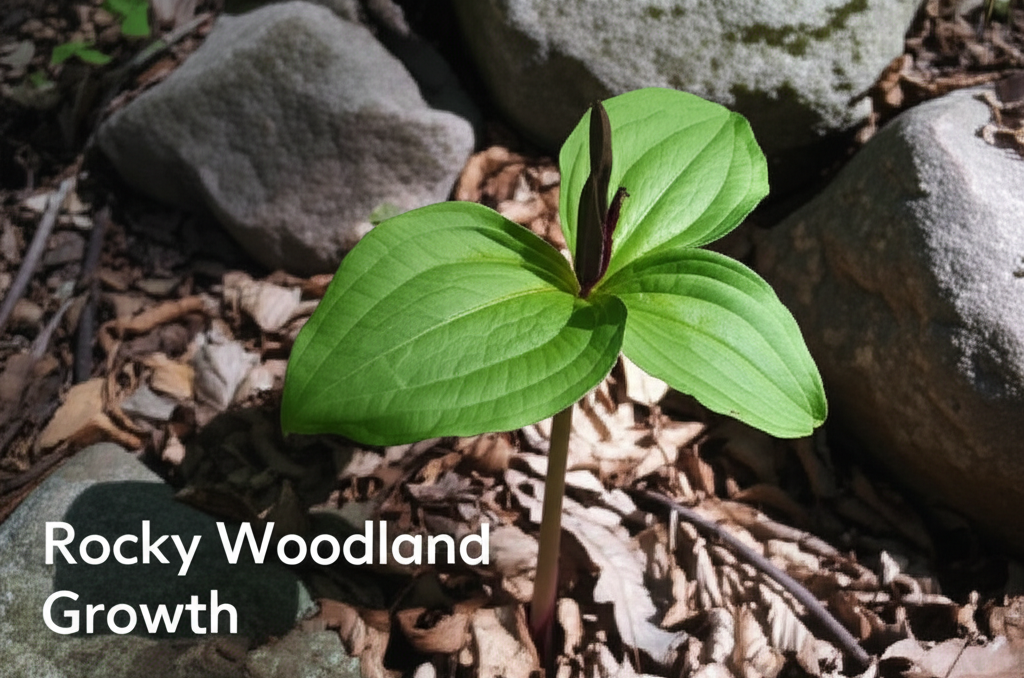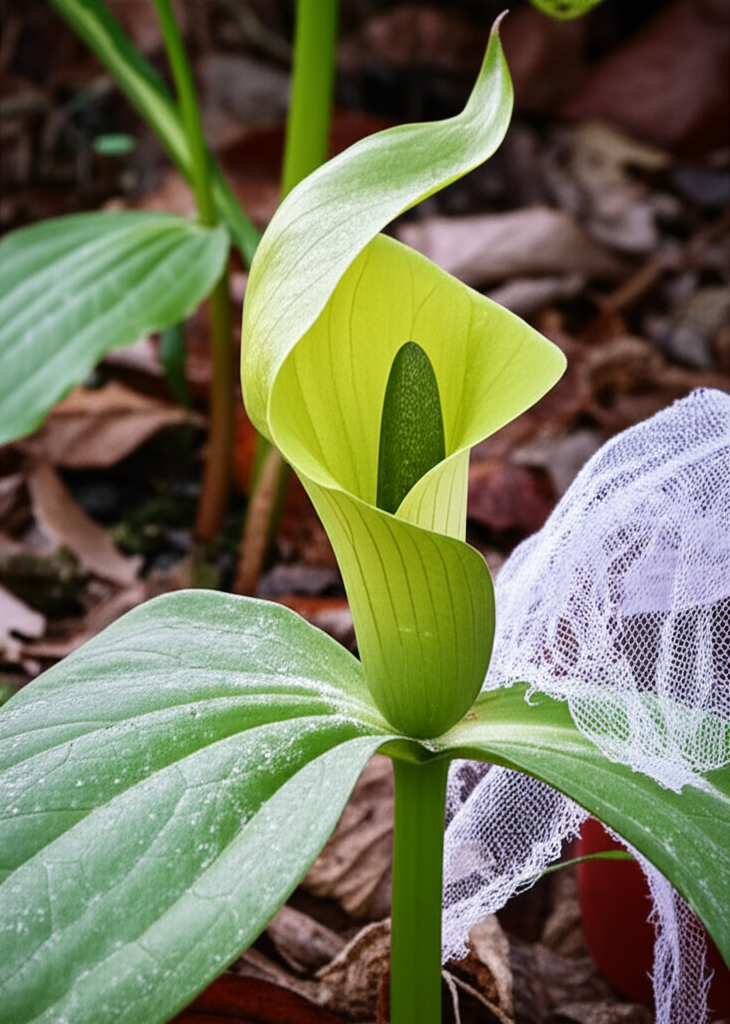The Enigmatic Jack-in-the-Pulpit: More Than Just Green
The Jack-in-the-Pulpit (Arisaema triphyllum) is a beloved woodland wildflower, instantly recognizable for its unique and somewhat comical hooded spathe. Often associated with a verdant green hue, this captivating plant actually boasts a surprisingly diverse palette of colors that can intrigue even the most seasoned botanist. From deep maroons to subtle stripes, the variations in Jack-in-the-Pulpit flower color are a testament to the subtle nuances of nature and the evolutionary adaptations that allow this species to thrive in varied forest environments. This article delves into the fascinating world of Jack-in-the-Pulpit color variations, exploring the factors that influence them and what these differences might signify.
Understanding the Anatomy: What We See as the “Flower”
Before we explore the color variations, it’s crucial to understand what constitutes the “flower” of the Jack-in-the-Pulpit. What most people perceive as the colorful bloom is actually a modified leaf structure called a spathe. This spathe encloses and protects the true flowers, which are small and insignificant, clustered on a fleshy spike called the spadix. The spadix is the “Jack” peeking out from the pulpit. The spathe’s primary role is to attract pollinators, and its coloration plays a significant part in this process.
The Dominant Palette: Common Jack-in-the-Pulpit Colors
While the image of a green Jack-in-the-Pulpit is prevalent, a closer look reveals a much richer spectrum.
The Classic Green
The most frequently encountered coloration is a predominantly green spathe. This can range from a light, almost yellowish-green to a deep, rich emerald. Often, these green spathes are subtly veined with darker green or even a hint of burgundy, especially along the edges and at the base.
The Striking Maroon and Purple Tones
Perhaps the most dramatic color variations involve deep maroon, burgundy, and even purplish hues. These colors can be solid throughout the spathe, or they can manifest as intricate patterns of stripes and mottling.
- Solid Maroon: Some specimens present a spathe that is almost entirely a rich, dark red-brown or burgundy. These are particularly striking and can appear almost black in dim woodland light.
- Striped Varieties: A common and beautiful variation involves stripes of maroon or purple running vertically along a green or lighter-colored spathe. The width and intensity of these stripes can vary significantly, creating unique visual appeals for each individual plant.
- Mottled Patterns: Other Jack-in-the-Pulpits display a more irregular, mottled pattern of purples and greens, giving them a painted or marbled appearance.
Subtle Earth Tones
Beyond the greens and purples, some Jack-in-the-Pulpits exhibit more subtle earth tones.
- Brownish Hues: Occasionally, you might find spathes with a more pronounced brownish or russet tint, often blending with green or maroon.
- Yellowish Undertones: While less common, some green spathes can have a distinctly yellowish cast, particularly when they are young or in specific environmental conditions.
Key Factors Influencing Jack-in-the-Pulpit Color Variations
The diversity in Jack-in-the-Pulpit coloration isn’t random. Several environmental and genetic factors contribute to this fascinating spectrum.
Genetics: The Blueprint for Color
The underlying genetic makeup of an individual plant is the primary determinant of its potential color. Like any species, Arisaema triphyllum possesses genes that code for pigment production. Variations in these genes can lead to differences in the type and amount of pigments produced, resulting in the observed color variations. While Arisaema triphyllum is a single species, it exhibits considerable genetic diversity across its range, which contributes to its varied appearances.
Environmental Influences: The Impact of the Habitat
While genetics sets the stage, the environment can play a crucial role in how those genetic potentials are expressed.
- Sunlight Exposure: The amount of sunlight a Jack-in-the-Pulpit receives can significantly influence its coloration. Plants growing in areas with dappled sunlight or partial shade often exhibit richer, deeper colors, particularly the purples and maroons. This is because increased sunlight can stimulate the production of anthocyanins, the pigments responsible for red, purple, and blue colors in plants. In deeper shade, the coloration might be more subdued or predominantly green.
- Soil Conditions: While less directly studied for color, soil pH and nutrient availability can indirectly affect plant health and pigment production. Healthy, well-nourished plants are generally better able to express their full genetic potential, including their color variations.
- Temperature: Fluctuations in temperature, especially during the development of the spathe, can also influence pigment synthesis. Cooler temperatures, particularly during the early stages of growth, are often associated with more intense red and purple coloration.
Age and Stage of Development
The color of a Jack-in-the-Pulpit can also change slightly as it matures. Young spathes might appear a lighter shade of green or have less pronounced striping. As the plant ages and the reproductive structures develop, the colors can deepen and become more prominent.
A Comparative Look at Color Variations
To better illustrate the diversity, let’s compare some common color profiles.
Table 1: Key Facts and Color Comparison
| Feature | Classic Green | Maroon-Striped | Deep Maroon/Purple |
| :—————- | :———————————————– | :———————————————– | :———————————————- |
| Primary Color | Green (light to dark) | Green base with maroon/purple stripes | Solid maroon, burgundy, or deep purple |
| Veining | Darker green or subtle burgundy | Prominent maroon or purple stripes | Can have subtle darker veining or be solid |
| Stripe Pattern| Absent or very subtle | Vertical, distinct stripes | Absent or integrated into the solid color |
| Sunlight Impact| Can be slightly more muted in deep shade | Deeper, richer colors in dappled sunlight | Richest in dappled sunlight or partial shade |
| Commonality | Most common | Relatively common | Less common than green, but frequently seen |
| Visual Appeal | Subtle, classic woodland beauty | Striking contrast, dynamic appearance | Bold, dramatic, and eye-catching |
The Significance of Color: Attracting Pollinators
The primary evolutionary purpose of the spathe’s coloration is to attract pollinators. While the exact pollinators for Jack-in-the-Pulpits can vary, they are typically small flies, gnats, and beetles that are drawn to the spadix.
- Visual Cues: The colors, patterns, and even the subtle scent emitted by the spadix act as visual and olfactory cues for these insects.
- Mimicry: Some researchers believe that the darker, more reddish-purple varieties might mimic decaying organic matter or carrion, which are attractive to certain fly species that serve as pollinators for this plant. The green and striped varieties might appeal to a broader range of insects.
- Environmental Adaptation: The specific coloration that is most successful in attracting pollinators can be influenced by the dominant insect populations in a particular habitat. This can lead to regional variations in color prevalence.
Cultivating and Identifying Color Variations
For gardeners and plant enthusiasts, understanding these color variations can add another layer of enjoyment to growing Jack-in-the-Pulpits.
Tips for Identifying and Cultivating
- Observe in Nature: The best way to appreciate the full spectrum is to explore different woodland areas during the blooming season. Look for variations in parks, nature preserves, and undisturbed forests.
- Seed Collection: If you find a particularly striking specimen, you might consider collecting seeds (responsibly, of course, and with permission if necessary). However, be aware that offspring from seed may not perfectly replicate the parent’s coloration due to genetic diversity.
- Division: Mature Jack-in-the-Pulpit plants often form clumps. Dividing these clumps can be a way to propagate a specific color form you admire.
- Provide Appropriate Conditions: To encourage vibrant coloration, aim to provide conditions similar to their natural habitat: moist, well-drained soil rich in organic matter, and dappled shade or partial sun.
Table 2: Cultivation Steps, Pros, and Cons of Color Variations
| Step/Aspect | Classic Green | Maroon/Striped Varieties | Deep Maroon/Purple Varieties |
| :——————- | :—————————————————- | :—————————————————– | :————————————————– |
| Cultivation Ease | Easy | Moderately Easy | Moderately Easy |
| Sunlight Needs | Dappled to partial shade | Dappled to partial shade; richer color in more light | Dappled to partial shade; requires good light for best color |
| Soil Needs | Moist, organic-rich, well-drained | Moist, organic-rich, well-drained | Moist, organic-rich, well-drained |
| Pros | Widely available, adaptable, classic woodland look | Striking visual interest, unique patterns | Bold statement, eye-catching, dramatic appeal |
| Cons | May be perceived as less “special” by some | Can be less common, harder to find specific patterns | May require slightly more specific light conditions for optimal color |
| Propagation | Seed, division | Seed, division | Seed, division |
Beyond the Spathe: Other Interesting Variations
While the spathe’s color is the most discussed, it’s worth noting other variations that can occur:
- Leaf Coloration: While typically green, the leaves of some Jack-in-the-Pulpits can sometimes exhibit purplish or bronzy undertones, especially when young or under stress.
- Berry Color: After flowering, the spadix develops a cluster of bright red berries. These are generally consistent in color but vary in size and abundance depending on pollination success.
Conclusion: A Tapestry of Woodland Wonders
The Jack-in-the-Pulpit is far more than just a green woodland curiosity. Its ability to display a spectrum of colors, from subtle greens with hints of burgundy to bold, solid maroons and intricate stripes, makes it a plant of remarkable beauty and diversity. Understanding the interplay of genetics and environment that drives these variations not only deepens our appreciation for this species but also highlights the subtle wonders that await discovery in our natural world. Whether you encounter a classic green specimen or a rare, deep purple one, the Jack-in-the-Pulpit continues to captivate with its unique form and fascinating color variations.
html
<h2>Jack-in-the-Pulpit Flower Color Variations: Key Facts/Comparison</h2>
<table>
<thead>
<tr>
<th>Feature</th>
<th>Typical Green/Brown</th>
<th>Purple/Maroon</th>
<th>Striped Variations</th>
<th>White/Pale Green</th>
</tr>
</thead>
<tbody>
<tr>
<td>Common Name</td>
<td>Jack-in-the-Pulpit, Bog Onion</td>
<td>Purple Jack-in-the-Pulpit, Red Jack</td>
<td>Striped Jack-in-the-Pulpit</td>
<td>Albino Jack-in-the-Pulpit (rare)</td>
</tr>
<tr>
<td>Spathe Color</td>
<td>Green with brown or purplish veins</td>
<td>Deep purple, maroon, or reddish-brown</td>
<td>Green or purplish spathe with contrasting vertical stripes (often purple or reddish)</td>
<td>Mostly white to pale green, sometimes with faint purplish streaks</td>
</tr>
<tr>
<td>Spadix Color</td>
<td>Typically greenish-yellow to brown, often club-shaped</td>
<td>Dark purple to brown, can be more pointed</td>
<td>Ranges from green to purplish, may have stripes mirroring the spathe</td>
<td>Pale green to white</td>
</tr>
<tr>
<td>Veining</td>
<td>Often prominent purplish or brownish veins</td>
<td>Veins can be less distinct against the dark background or a slightly lighter shade</td>
<td>Key characteristic; distinct vertical stripes of contrasting color</td>
<td>Faint or no visible veining</td>
</tr>
<tr>
<td>Rarity</td>
<td>Most common</td>
<td>Moderately common, depending on region</td>
<td>Less common than typical green/brown, but more prevalent than pure white</td>
<td>Rare</td>
</tr>
<tr>
<td>Habitat Preference</td>
<td>Shaded, moist woodlands, swamps</td>
<td>Similar to typical; may show a slight preference for richer soils</td>
<td>Similar to typical</td>
<td>Similar to typical; often associated with healthy, undisturbed environments</td>
</tr>
</tbody>
</table>
<h2>Jack-in-the-Pulpit Flower Color Variations: Steps/Pros-Cons</h2>
<table>
<thead>
<tr>
<th>Aspect</th>
<th>Typical Green/Brown</th>
<th>Purple/Maroon</th>
<th>Striped Variations</th>
<th>White/Pale Green</th>
</tr>
</thead>
<tbody>
<tr>
<td>Cultivation Steps</td>
<td>Plant rhizomes in moist, well-drained soil in partial to full shade. Keep soil consistently moist.</td>
<td>Same as typical. Some propagation can be done from rhizome division.</td>
<td>Same as typical. Seed propagation can be slow and may not always produce striped offspring.</td>
<td>Difficult to propagate reliably. Seed germination can be unpredictable. Primarily found in the wild or through specialized growers.</td>
</tr>
<tr>
<td>Pros</td>
<td>Hardy, adaptable, readily available. Provides classic woodland aesthetic.</td>
<td>Adds striking color and visual interest to shade gardens. Unique appeal.</td>
<td>Highly decorative due to unique patterning. Conversation starter.</td>
<td>Extremely unique and rare, offering an unusual focal point.</td>
</tr>
<tr>
<td>Cons</td>
<td>Can be less visually striking than colored or striped varieties.</td>
<td>May be slightly less vigorous than typical green forms in some conditions. Can be mistaken for diseased plants by the uninitiated.</td>
<td>Can be more challenging to find. Color intensity and stripe clarity can vary significantly between individuals.</td>
<td>Very difficult to find and cultivate. Color can be inconsistent. May be susceptible to environmental stress.</td>
</tr>
</tbody>
</table>

